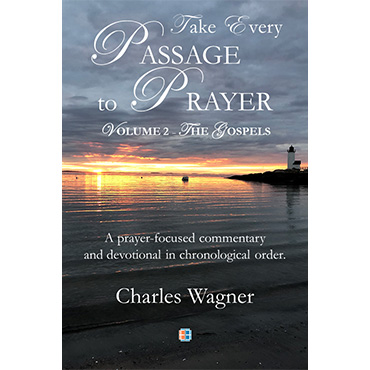The Gramazin Blog

Jesus in Jerusalem: Clears the Temple Courts
Take Every Passage to Prayer - Volume 2, The Gospels
Friday June 07, 2024
John 2:13-25
Father, give me a fervent and fearless passion for Your honor and glory. I don’t want to cower in fear when the time calls for a man of God to stand up for Your glory. Please give me “good works” to do, not to earn salvation, but to lead people to ask why I do them so that I can give You the glory. Amen.
Father, from Capernaum, Jesus and his disciples walked approximately 100 miles south to Jerusalem for the Passover . When Jesus arrived in the temple courts, He found people “selling cattle, sheep and doves, and others sitting at tables exchanging money (NIV).” Jesus was furious, a righteous fury fed by deep love for His Father in heaven. “He made a whip out of cords, and drove all from the temple courts, both sheep and cattle; he scattered the coins of the money changes and overturned their tables. To those who sold doves he said, ‘Get these out of here! Stop turning my Father’s house into a market!’ (NIV)” This was the prophetic fulfillment of Psalm 69:9.
Father, what are a few of the conclusions I come to from this passage?
- The Holy Spirit had turned the gentle Jesus of His youth into a confident and courageous defender of the glory of God. He was a soldier, fighting for Your honor (Philippians 2:25, 2 Timothy 2:3-4, Philemon 1:2, Ephesians 6:10-17).
- Jesus was physically strong, from His years as a carpenter, and, most likely, from additional strength He had received from the Holy Spirit.
- The people in the temple courts were not expecting this. Perhaps if they had, they might have resisted Jesus more. When sin becomes a comfortable norm, we do not expect sudden judgement from God.
- What was the great offense? The temple is the place for the people to feel remorse for their sins, to confess their sins, and to seek God’s forgiveness through the shedding of the innocent blood of sacrificial lambs. Instead, the people don’t care about their relationship with God. Their sin doesn’t bother them. They view the confession of sin and the sacrificing of innocent blood as a means to make money to satisfy the desires of their flesh. I can only imagine the wrath of Jesus for unrepentant sinners on Judgement Day. This reminds me of another time when the greatest sacrifice of all, the Lamb of God, hung on a cross while the soldiers cast lots for His clothing (Matthew 27:34-36).
- Judgement from Your hand can come suddenly and unexpectedly (Luke 12:19-21, Daniel 5:22-31).
- Jesus is now on the “grid”, as we would say in the 21st century. Whatever leaders in Jerusalem hadn’t heard of Him to this point sure heard of Him now. He is no doubt the talk of the town. John does not tell us that word had come down from 100 miles away that He had turned water into wine. Therefore, it is unlikely that the people of Jerusalem suspected this was the Son of God who had overturned the tables in the temple. They had not seen a miracle yet. Jesus was most likely presumed to be a mere man who was raging.
“Who are you to do this to us?” the Jews said as they got into Jesus’ face after He destroyed their business. I suspect that someone with Him, such as a disciple, stated that He was the Son of God. If Jesus had said that, John most likely would have quoted Him as such. In response, the Jews demand proof that He is the Son of God. They want a miracle of some sort, right then and right there.
Instead, Jesus says that the only sign that He needs to give them is the only sign that counts - He will be raised from the dead on the third day after being crucified. In other words, three years from now, when these things transpire, these Jews, as well as His disciples, will remember this day when He said this will happen. Jesus is making it clear, at the beginning of His ministry, where His ministry is heading - to His crucifixion and resurrection.
Jesus used a metaphor to speak of His death and resurrection. He said that they will “destroy” (kill) this temple (Jesus) and “I” (Jesus) will raise it again (rise from the dead) in three days (on the third day).” However, they took Jesus literally, thinking He had said He would rebuild the temple on His own in three days after it took 46 years to be remodeled by a team of men. They no doubt mocked Jesus as the confrontation ended.
The second chapter of John concludes with a statement that “many people saw the signs he was performing and believed in his name (NIV).” What signs were these? Were the signs referring to what He did in the temple? Were the signs referring to news from Cana that He had turned water into wine? Or, is it likely that Jesus performed other miracles in Jerusalem during the Passover that were not recorded in the gospels? Considering John 20:30-31 and John 21:25, I believe the third reason is the answer.
As a result of these signs, Jesus is becoming the celebrity He didn’t want to be. He was receiving many compliments from a variety of people. However, none of their compliments touched His heart. He knew that the people were wicked and foolish in their unrepentant hearts. Therefore, their assessment of Him was meaningless to Him (Genesis 6:5, Numbers 23:19, 1 Samuel 16:7, Psalm 2, Romans 3:23). Amen.
Footnotes
109. The Passover occurs in the Jewish month of Nissan, which is approximately March and April. I believe the year was 27-28 AD, with Jesus’ death and resurrection to occur in 30-31 AD.
110. This was the first of two times Jesus would overturn the tables in the temple. The first was here at the beginning of His ministry. The second will be at the end of His ministry three years later, also during the week of Passover when He is crucified (Matthew 21:12-17, Matthew 26).
111. Consider Judges 14:6 - the Holy Spirit gave Samson his great strength to tear a lion apart with his bare hands.
112. Wait a minute. Why is Jesus so concerned about people not knowing He performs miracles, but He wasn’t shy at all about overturning the tables in the temple courts? I believe the answer is as simple as this - the general public wasn’t impressed He overturned the tables in the temple courts. That’s not their business. It doesn’t concern them. However, the general public does care about the blind being able to see, the dumb being able to speak, and the lame being able to walk. It is Jesus’ miracles, and not His judgement of the people in temple, that will create crowds of people. The leaders in Jerusalem are not going to kill Him for turning over a few tables. They will kill Him for leading thousands of people to believe He is the Son of God.
113. The temple referred to in this passage was the Second Temple, which stood on the Temple Mount in Jerusalem. It was remodeled and extensively expanded by Herod the Great. Like the first temple, Solomon’s temple, which was destroyed by the Babylonians, this Second Temple was destroyed by the Romans in 70 AD to punish the Jews for their revolt against Rome. The Second Temple lasted for nearly 600 years (516 BC to 70 AD). Jesus predicted the destruction of this temple (Matthew 24). The Islamic Dome of the Rock is now located on the same footprint as the Second Temple. The Western Wall of this temple, also known as the Wailing Wall, remains in Jerusalem today.







